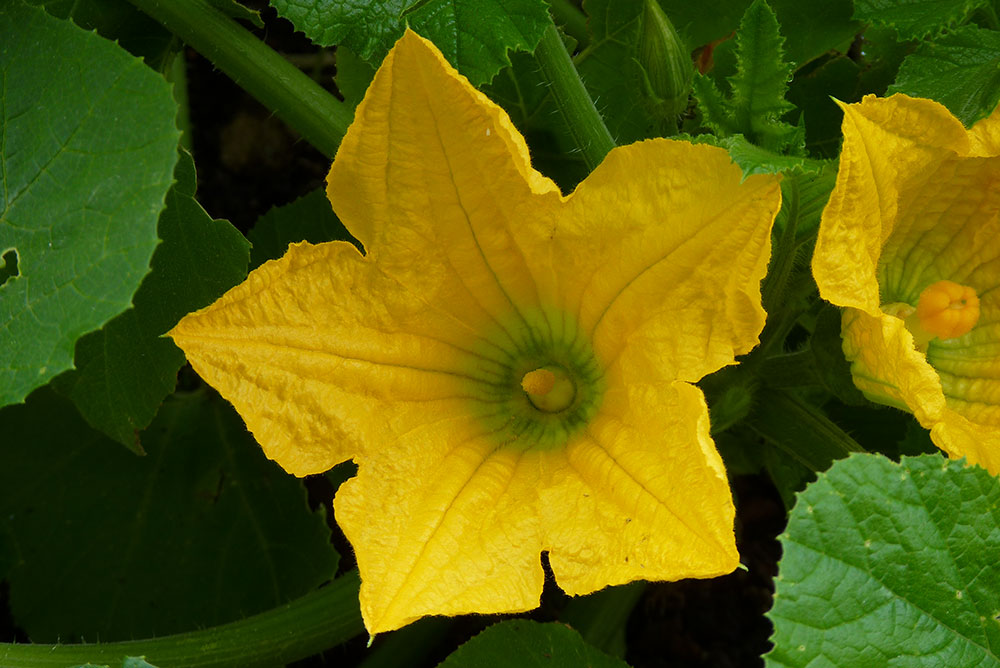Courgette (Cucurbita pepo)
Flower biology
- The courgette has male and female flowers on the same plant.
- Both flower types produce nectar (only the male flower produces pollen).
- The flowers are very large. Each bloom opens immediately after sunrise, just for a few hours.
- Visiting bumble bees easily collect the pollen on their furry coats when they fly from flower to flower. They lose the pollen grains, however, when they try to scrape them off their coats and into the pollen baskets on their hind legs, as courgette pollen is relatively large and sticky. As a result, bumble bees do not manage to take much pollen back to the nest when they work in courgette. For proper development of the colony, supplementary feeding with pollen (from other plants) is required.
- It can easily be determined if a flower has been visited by bumble bees, as pollen grains will be present on the stigma of the female flower if this is the case. The stamen of the male flower will also be partially or completely stripped of pollen grains.

Introduction schedule
- For pollination of courgette, MEDIUM colonies are normally used. On delivery, a MEDIUM colony consists of 50 to 70 worker bees. The colony has an expected life span of 4-6 weeks.
- The approximate pollination range per hive is 1,000 m². For smaller areas, another type of hive may be suggested by your consultant.
Instructions for use
- Colonies should be introduced when the first flowers are open.
- Colonies should be placed on a sturdy support, about 50 cm above the ground; in spring in a sunny place, and later in the season in the shade.
- Secure the hive so that ants cannot enter it.
- After placement of the hive, let the bumble bees settle down for a while (½ - 1 hour) before opening the flight hole.
- Following their initial orientation flights the bumble bees will immediately start pollinating the crop.
- Bumble bees are active at temperatures between 10 and 30 degrees Celsius. They function best at temperatures between 15 and 25 degrees Celsius.
- The nectar production of the courgette flower may be so great that large nectar supplies will be stocked up in the bumble bee nest. It is accordingly desirable to lock the bumble bees up (using the BEEHOME option) every day after the flowers close (see flower biology). In this way, they will be prevented from foraging outside the glasshouse for the rest of the day. Otherwise the food supply might increase to such an extent that they will not be very motivated to visit the new courgette flowers the next morning.
Crop protection
- Combining the use of bumble bees with natural enemies does not present any problems.
- Agricultural chemicals may have direct or indirect effects on the bumble bees. Direct effects occur when worker bees and larvae die as a result of contact with or digestion of a chemical product, indirect effects occur when the smell of the treated flower puts off the bumble bees, causing visits to stop.
- Systemic pesticides (pesticides that are absorbed through the roots) often have a long-lasting residual effect. If a flower produces nectar in addition to pollen (e.g. sweet pepper), the damage to the bumble bee population may be much more serious than in a crop that only produces pollen (e.g. tomato).
- You will find detailed information about persistence and compatibility of pesticides with bumblebees and most other beneficials in Zonda's Side Effects Guide or online at Koppert’s website: www.koppert.nl
- In all cases the BEEHOME option of the hive must be activated before the crop is treated. This option ensures that bumble bees can enter, but not leave the hive. After about an hour the hive can be closed completely, so that it can either be covered or removed from the crop.
- If the hive is temporarily removed from the crop, it should be stored at 18 to 20 degrees Celsius.
Need more help with our product?
Please call us on 0800 496 632